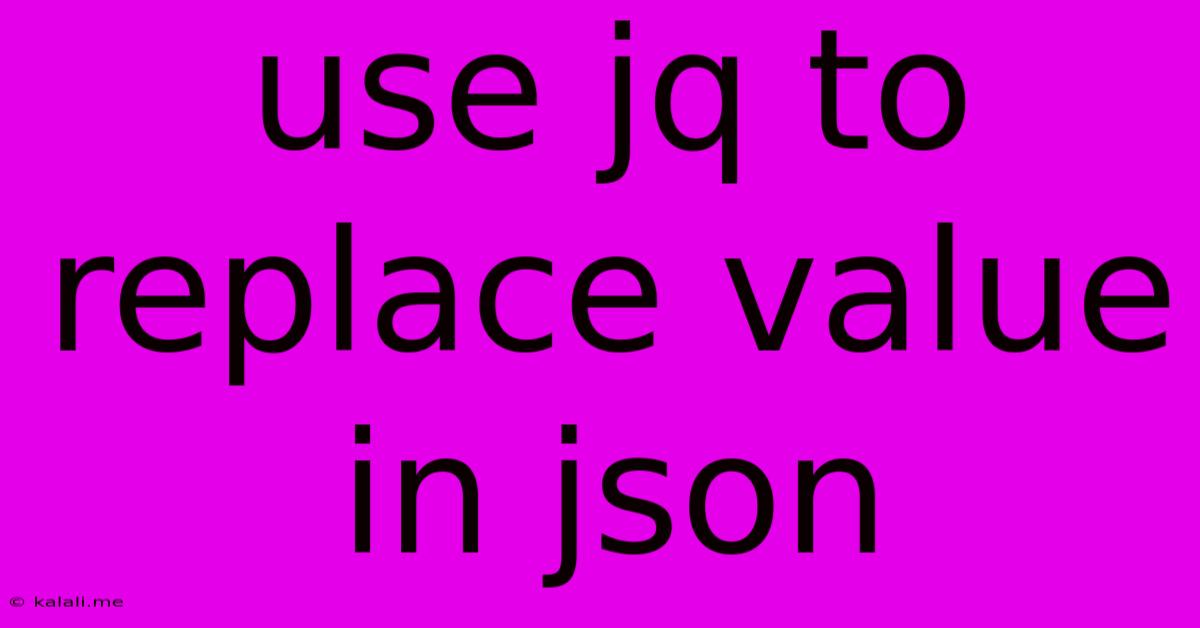Use Jq To Replace Value In Json
Kalali
May 25, 2025 · 3 min read

Table of Contents
Mastering JSON Value Replacement with jq: A Comprehensive Guide
This article provides a comprehensive guide on using jq, a powerful command-line JSON processor, to efficiently replace values within JSON documents. Whether you're a seasoned developer or just starting out, mastering jq's value replacement capabilities is a crucial skill for anyone working with JSON data. We'll cover various scenarios, from simple value changes to complex conditional replacements, empowering you to manipulate JSON with precision and ease.
Understanding the Basics: jq Syntax and Selection
Before diving into value replacement, let's establish a fundamental understanding of jq's syntax and object selection. jq uses a concise query language to traverse and modify JSON structures. The core of its functionality revolves around selecting specific elements within a JSON document using path expressions. For instance, to access the "name" field within a JSON object, you'd use .name.
Let's assume we have a simple JSON file named data.json:
{
"name": "John Doe",
"age": 30,
"city": "New York"
}
To extract the "name" value, you would use the following command:
jq '.name' data.json
This will output:
"John Doe"
Replacing Values: The |= Operator
The heart of value replacement in jq lies in the |= operator. This assignment operator allows you to modify an existing value in place. The general syntax is:
.field |=
This command will replace the value associated with the .field path with the result of <expression>.
Example: Replacing the "city" value
To change the "city" from "New York" to "London", you would use:
jq '.city |= "London"' data.json
This will output:
{
"name": "John Doe",
"age": 30,
"city": "London"
}
This command modifies the city field directly. To save the changes back to the file, use redirection:
jq '.city |= "London"' data.json > updated_data.json
Handling Nested Objects and Arrays
jq's power extends to handling complex nested JSON structures. You can navigate nested objects and arrays with the dot (.) operator and array indexing ([]).
Example: Replacing a value within a nested object
Consider a more complex JSON:
{
"person": {
"name": "Jane Doe",
"address": {
"street": "123 Main St",
"zip": "10001"
}
}
}
To change the zip code to "10010", the command would be:
jq '.person.address.zip |= "10010"' data.json
Example: Replacing values within an array
For arrays, you can access elements by their index. To change the second element of an array:
.myArray[1] |= "new value"
Conditional Value Replacement
jq supports conditional statements using the if and else keywords. This allows for powerful, context-aware value replacements.
Example: Conditional replacement based on age
Let's say you want to replace the age with "adult" if the age is greater than or equal to 18.
.age |= if . >= 18 then "adult" else tostring end
Advanced Techniques: Functions and Built-in Filters
jq provides numerous built-in functions and filters that can be incorporated into value replacement operations for even more sophisticated transformations. For example, you can use the gsub function for string manipulation during replacement, or utilize the map function for transforming arrays.
Conclusion
jq offers an incredibly powerful and flexible way to replace values within JSON documents. By mastering the techniques outlined in this guide, you'll gain the ability to efficiently manage and manipulate your JSON data, streamlining your workflow and enhancing your productivity. Remember to explore jq's extensive documentation for even more advanced features and capabilities. Experiment with different scenarios and practice regularly to fully harness the potential of this valuable tool.
Latest Posts
Latest Posts
-
How Many Days Is In 11 Weeks
Jul 14, 2025
-
How Many Grams Are In One Tola Gold
Jul 14, 2025
-
How Many Oz In A Pound Of Freon
Jul 14, 2025
-
How Many Years Are In A Millennia
Jul 14, 2025
-
Words With C As The Second Letter
Jul 14, 2025
Related Post
Thank you for visiting our website which covers about Use Jq To Replace Value In Json . We hope the information provided has been useful to you. Feel free to contact us if you have any questions or need further assistance. See you next time and don't miss to bookmark.